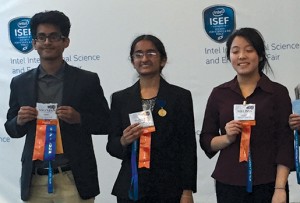Intel International Science and Engineering Fair 2015
Yu Cheng, University of Pittsburgh and ASA Pittsburgh Chapter President, and Douglas Splitstone, Splitstone & Associates
The Pittsburgh Chapter of the ASA participated in the 2015 Intel International Science and Engineering Fair (ISEF), which was held in the Pittsburgh convention center May 10–15. The ISEF is the largest pre-college science and engineering fair in the world.

From left: Niranjan Balachandar, 18; Yashaswini Makaram, 17; and Melissa Amber Yu, 18, show off their ribbons at the 2015 Intel International Science and Engineering Fair, held in May in Pittsburgh, Pennsylvania.
This year, there were 1,354 projects presented by 1,698 secondary school students ranging in age from 10–20. These students represented 77 countries and territories. All 50 U.S. states were represented, as well as American Samoa, Puerto Rico, and the U.S. Virgin Islands.
Fifteen local and outside judges, led by Chad Schafer of Carnegie Mellon University, contributed their time to canvassing the 1,354 projects and identifying the award winners. Most judges were impressed by the breadth of knowledge and intellectual maturity many of the students possess. Following is a summary of those projects recognized by the ASA for the best use of statistics.
1st Place
Melissa Amber Yu, 18, Farragut High School, Knoxville, Tennessee
Developing an Automatic Nonrigid Image Registration Algorithm for Nanoscience Research
Melissa developed an automatic nonrigid image registration algorithm to correlate distorted low-resolution hyperspectral data with less distorted high-resolution spatial data. The algorithm used bivariate polynomials and built on methods such as scale invariant feature transform and random sample consensus to improve the accuracy of the registration by identifying locally distorted keypoints and minimizing the impact of false matches. An application-specific outlier rejector was also developed based on mutual information. Several judges had a chance to review the project and interview Melissa. We were all impressed by the sophistication of the project and some of us even wondered whether we could do as well as Melissa did.
2nd Place
Yashaswini Makaram, 17, Massachusetts Academy of Math and Science, Worcester, Massachusetts
The Phoney Lift: Using Accelerometers to Identify People
The second-place winner developed a new level of cell phone security based on the unique motions the owner uses to pick up their phone. The motions used by a non-owner were then statistically compared with those of the owner. The algorithm of classifying users as an owner or non-owner was tuned using a receiver operating characteristic curve to identify the optimum operating point. The clever study design and use of statistics in the project made it well deserved for second place.
3rd Place
Niranjan Balachandar, 18, Texas Academy of Mathematics and Science, Denton, Texas
A Novel Coevolution Data-Based Approach for Computational Drug Design to Target Intrinsically Disordered Proteins
The third-place winner developed statistical algorithms to identify disordered proteins and investigate their genetic modification via statistical simulation to improve their therapeutic properties while retaining their cell binding properties. Niranjan demonstrated its application and efficacy with Hepatitis C. There is the promise that his technique will drastically speed up the development of genetically based therapies for other conditions, notably cancer, as well.
In addition, there were seven honorable mentions with such diverse topics as adolescent health, mathematical analysis of Ebola transmission, functional neural networks, development of bakery product, galaxy star formation, novel biomarker algorithm for early cancer detection, and Arctic sea ice melting.
The three award winners received $1,500, $1,000, and $500 for the first, second, and third prizes, respectively. All American Statistical Association finalists received one year of ASA membership, which includes subscriptions to Significance and CHANCE. In addition, Taylor & Francis Group and Cengage Learning donated magazines and books to participating students.

















